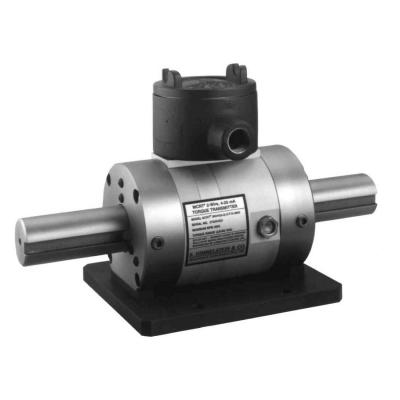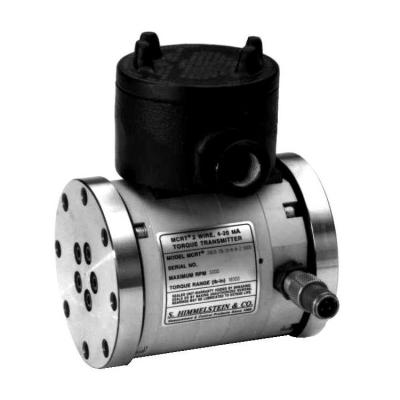Torque measurements provide a way of monitoring and controlling processes. They can verify correct installation and assembly of fasteners and components and they are used for calibrating torque-applying equipment. A torque transmitter is a torque measurement device that provides a 4-20mA output proportional to torque. In contrast to voltage output, current offers better immunity to electrical noise.
S. Himmelstein and Company torque transmitters have excellent noise immunity, which contributes to their exceptional precision. These electronic transmitters are available in floating and foot-mounted designs, are straightforward to install, and reliable in service.
Torque Measurement Basics
The best way of getting direct torque measurements is with strain gauges embedded in the shaft. A strain gauge is a thin wire with an electrical resistance that varies in proportion to compression and extension. In our 4-20mA transducer, four strain gauges are coupled in a Wheatstone bridge arrangement. By applying an excitation voltage, it’s possible to measure twist in the shaft due to torque without readings being affected by bending.
The Rotary Transformer
Rather than use slip rings with all their associated limitations, we have invented the rotary transformer. This enables higher speed operation without the friction, wear and electrical issues of slip rings. The rotary transformer operates in concert with sophisticated signal conditioning. This supplies the excitation and filters and amplifies the output signals.
Torque Transmitter Applications
Any application that would benefit from 4-20mA output is a candidate. This is especially true in electrically noisy environments like those where VFDs are used. Process equipment such as mixers, extruders and reactors are examples — as are conveyors, fans, blowers and machine tools. Plastics, rubber, chemicals, the automotive sector and metal cutting are just a few of the industries that could benefit.
Choosing a Torque Transmitter
Our torque transmitters offer some of the highest precision and noise immunity, in a package that’s straightforward to install and reliable in service. The transmitter circuitry is shielded from EMI, which, combined with the current output, creates a torque sensor with excellent noise immunity.
The MCRT® 39000X series is available as a shaft end and a flanged torque transmitter. A shaft-end torque transmitter may be floated or foot-mounted, but flanged transmitters must be mounted as floating shafts. When choosing between installation methods, note that a floating torque transmitter can handle much higher thrust loads than one that’s foot-mounted. Axial loads limit how much thrust a foot-mounted torque transmitter can handle.
Both shaft-end and flanged styles are fully bidirectional and come with NIST traceable calibration. In addition, the two-wire output is switchable between 4-20mA and 12+/- 8mA modes.
Torque Measurement Specialists
All we do is torque measurement. Our focus as a dedicated torque transmitter company, plus experience dating from 1960, ensures every torquemeter that leaves our site delivers excellent performance at an affordable price. As your torque transmitter manufacturer of choice, we have an on-site calibration laboratory certified to ISO 17025 and a machine shop capable of the highest-precision work.
Torque measurement is a complicated activity. Learn how we can support your application by contacting us today.


